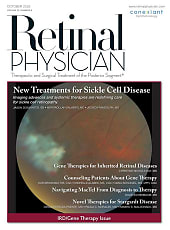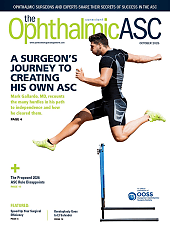Due to its anti-inflammatory, anti-scarring, and regenerative properties,1,2 cryopreserved amniotic membrane (CAM) transplantation has become an essential tool in oculo-
plastic surgery. However, at press time, BioTissue Ocular’s CAM360 is the only such product recognized by the US Food and Drug Administration for that purpose.3
Like traditional mucous membrane grafts or skin grafts, CAM can serve as a biological graft—but without donor-site morbidity. It contains growth factors and other components that promote epithelialization and improve surgical outcomes.4 While CAM can be used in conditions ranging from cicatricial entropion and symblepharon to socket contracture and implant exposure, it is particularly useful in reconstructing the delicate tissues of the eyelid and orbit, which is one of the greatest challenges in oculoplastic surgery.
CAM vs Other Grafts
Mucous membrane grafts are commonly used for addressing cicatricial diseases and forniceal reconstruction,5,6 as they are biologically similar to conjunctival tissue and can therefore mimic both its structure and function.7 Conjunctival autografts can also be useful in some cases; however, sacrificing healthy conjunctiva from another area can potentially complicate a patient’s long-term ocular health.
Surgeons have also turned to skin grafts and allografts when seeking tissue for oculoplastic reconstruction. Skin grafts, while available and accessible, are poorly suited to the conjunctival environment, often creating mismatches in texture and function.8 Commercially available allografts have also been introduced for fornix reconstruction and socket lining.9 While these products have their place in our armamentarium, I find that their increased rigidity makes them less ideal for use in some patients. By contrast, CAM provides both pliability and structure, and I find it easier to manipulate during oculoplastic surgery.
I prefer CAM to other options primarily because it requires no tissue harvesting, eliminating additional surgical time and avoiding donor-site morbidity. My patients who undergo mucous membrane harvesting have reported symptoms such as discomfort, difficulty eating, persistent soreness in the mouth, and ocular discharge or odor, so I try to avoid the potential for these complications to arise whenever possible.
Another reason I prefer CAM is the biological advantage it offers from the preservation of the heavy-chain hyaluronic acid/pentraxin 3 complex. The presence of this extracellular matrix complex provides CAM with its anti-inflammatory properties, which help to reduce scarring.10 These characteristics make CAM an especially versatile and effective choice for complex reconstructive scenarios.
Types and Processing of Amniotic Membranes
Amniotic membranes (AMs) can be broadly divided by thickness; thinner preparations dissolve more quickly and are therefore well suited for ocular surface protection. Thicker grafts derived from the section extending to the umbilical cord are much thicker and therefore offer greater tensile strength and handling stability; this makes them more advantageous for oculoplastic surgery, as they are better able to withstand sutures, support the weight of prosthetic devices, and create deeper fornices in contracted sockets.11 Thickness is a key factor that guides my decision when selecting the appropriate AM for my patients.
Another important distinction lies in how AMs are processed: the cryopreservation used to process CAM preserves the biological components responsible for the membrane’s key anti-inflammatory and antifibrotic properties.12 Dehydrated membranes, by contrast, require rehydration before use and tend to lose a significant amount of these key growth factors and biological components during processing. While both options are clinically useful, CAMs are more biologically active. I also find them easier to handle than dehydrated membranes, which can be fragile after rehydration. Most CAMs require refrigeration at very low temperatures for proper storage, where dehydrated membranes do not.10
CAM in Oculoplastics: Surgical Techniques
While AMs have a wide range of applications in oculoplastic surgery, I find them particularly useful in orbital and eyelid reconstruction.1 In the orbit, I frequently use CAM following enucleation or evisceration to prevent implant exposure. I use thicker, umbilical-cord-
derived CAMs in this setting, especially in patients with shallow fornices and those with socket contracture. By creating structural depth and allowing conjunctiva to grow over the graft, CAM can help restore proper anatomy and improve prosthetic retention.11
In eyelid disease (particularly cicatricial entropion, where conjunctival shortage forces the margin inward), the CAM serves as a substrate graft. It provides a framework for re-epithelialization, correcting malposition and reducing discomfort.13
I find CAM to be most beneficial for treating conditions where minimizing postoperative inflammation and fibrosis is essential, as in Stevens-Johnson syndrome or revision surgery in the setting of significant preexisting scarring. In such challenging cases, CAM provides a biologic scaffold that can foster re-epithelialization, accelerate healing, and reduce inflammation, all of which are factors that can contribute to improving cosmetic outcomes and patient comfort. These advantages have made CAM my preferred option for complex oculoplastic reconstruction.
When addressing socket contracture or a very narrow fornix, my approach differs slightly. I begin by working underneath the native tarsus and making an incision down toward the orbital rim to create a deep pocket. I place the CAM allograft into that pocket to essentially form a new fornix. To secure it, I pass full-thickness sutures through the reconstructed fornix and the graft, anchoring them to the periosteum and externalizing the sutures through the skin. Typically, I place 3 or 4 stitches before inserting either the patient’s prosthetic or a conformer. To provide added support, I also place a band in the inferior fornix, which reinforces the reconstruction before the prosthetic is fitted. Finally, I perform a temporary tarsorrhaphy, patch the patient, and allow them to heal for about a week before removing sutures.
In cicatricial entropion, I use a slightly different technique; after releasing the scar bands or symblepharon bands that are tethering the eyelid margin inward, I cover the resulting conjunctival defects with CAM. I then suture the graft into place so the conjunctiva can drape smoothly over it, allowing the eyelid to return to a more natural position and preventing recurrent scarring. The allograft also provides a biologic substrate that supports epithelialization.
Patient Case: Socket Reconstruction With CAM
In one case, I saw a male patient in his 70s who presented with a blind, painful eye following trauma. I subsequently performed an enucleation, and while the initial healing was straightforward, soon afterward the patient began having difficulty retaining the conformer, which repeatedly dislodged during the early postoperative period. Over time, progressive contraction developed in both the superior and inferior fornices. Typically, I would send patients for prosthetic fitting roughly 6 weeks after enucleation, but in this instance the ocularist was unable to fit a prosthetic because the fornices were too shallow.
I had a detailed discussion with this patient, and he conveyed a strong wish to achieve prosthetic wear. As such, I brought him back to the operating room about 3 months later to reform both the superior and inferior fornices using 2 separate umbilical-cord-derived CAM allografts. The operation followed my standard approach: deepening the fornices, placing the grafts, passing full-thickness sutures to anchor them securely, and reinforcing the repair with a band. Once the reconstruction was complete, I inserted the prosthetic to provide counterpressure, patched the patient, and allowed time for healing.
At the 1-week follow-up, the prosthetic was in an excellent position, and the patient was very satisfied with the cosmetic result. At 3 and 6 months, the prosthetic continued to fit comfortably and securely, with no issues of retention.
Other Applications of CAM
Outside of oculoplastics, CAM has an ever-widening range of uses in ophthalmology. In one novel application, Alon Kahana, MD, PhD, described using umbilical-cord-derived CAM during corneal neurotization by wrapping it around the nerve coaptation site, further illustrating the versatility of the growth factors and biological components contained within these tissues.14 Patients with scarring from trauma, burns, or prior surgery also benefit from the regenerative environment provided by CAM.15
Conclusion
By reducing inflammation, limiting scarring, and promoting conjunctival healing, CAM offers advantages over other grafts and may increase the likelihood of achieving optimal outcomes, even in complex cases. Its combination of structural support and regenerative potential is a real boon, helping restore function, comfort, and quality of life for patients with challenging reconstructive needs. OM
References
1. Parikh AO, Conger JR, Li J, Sibug Saber M, Chang JR. A review of current uses of amniotic membrane transplantation in ophthalmic plastic and reconstructive surgery. Ophthalmic Plast Reconstr Surg. 2024;40(2):134-149. doi:10.1097/IOP.0000000000002494
2. Hopkinson A, Figueiredo FC. A narrative review of amniotic membrane transplantation in ocular surface repair: unveiling the immunoregulatory pathways for timely intervention. Ophthalmol Ther. 2025;14(7):1385-1409. doi:10.1007/s40123-025-01143-w
3. Data on file. BioTissue Ocular, Inc.
4. Topcu H, Serefoglu Cabuk K, Cetin Efe A, et al. The current alternative for ocular surface and anophthalmic socket reconstruction, cryopreserved umbilical amniotic membrane (cUAM). Int Ophthalmol. 2024;44(1):274. Published 2024 Jun 25. doi:10.1007/s10792-024-03232-4
5. Singh S, Malhotra R, Watson SL. Mucous membrane grafting for cicatricial entropion repair: review of surgical techniques and outcomes. Orbit. 2024;43(4):539-548. doi:10.1080/01676830.2023.2204498
6. Kheirkhah A, Blanco G, Casas V, Hayashida Y, Raju VK, Tseng SC. Surgical strategies for fornix reconstruction based on symblepharon severity. Am J Ophthalmol. 2008;146(2):266-275. doi:10.1016/j.ajo.2008.03.028
7. Ghadiali L, Winn B. Orbit: eye socket reconstruction with mucous membrane graft. In: Rosenberg ED, Nattis AS, Nattis RJ, eds. Operative Dictations in Ophthalmology. Springer; 2017:585-587. doi:10.1007/978-3-030-53058-7_130
8. Aryasit O, Panyavisitkul Y, Damthongsuk P, Singha P, Rattanalert N. Factors affecting anophthalmic socket reconstruction outcomes using autologous oral mucosal graft. BMC Ophthalmol. 2024;24(1):150. Published 2024 Apr 4. doi:10.1186/s12886-024-03301-3
9. Park SJ, Kim Y, Jang SY. The application of an acellular dermal allograft (AlloDerm) for patients with insufficient conjunctiva during evisceration and implantation surgery. Eye (Lond). 2018;32(1):136-141. doi:10.1038/eye.2017.161
10. Cooke M, Tan EK, Mandrycky C, He H, O’Connell J, Tseng SC. Comparison of cryopreserved amniotic membrane and umbilical cord tissue with dehydrated amniotic membrane/chorion tissue. J Wound Care. 2014;23(10):465-476. doi:10.12968/jowc.2014.23.10.465
11. Bunin LS. Reconstruction with umbilical amnion following ocular evisceration: A case study. Am J Ophthalmol Case Rep. 2022;26:101462. Published 2022 Mar 1. doi:10.1016/j.ajoc.2022.101462
12. Tseng SC. HC-HA/PTX3 purified from amniotic membrane as novel regenerative matrix: insight into relationship between inflammation and regeneration. Invest Ophthalmol Vis Sci. 2016;57(5):ORSFh1-ORSFh8. doi:10.1167/iovs.15-17637
13. Parikh, A & Chang, J. Tarsal fracture operation with amniotic membrane transplantation for cicatricial entropion. JFO Open Ophthalmology. 2024;5:100081.
14. Kahana A. Pearls for the treatment of patients with neurotrophic keratitis: optimizing corneal neurotization outcomes with cryopreserved amniotic membrane. Ophthalmology Times. June 21, 2024. Accessed October 14, 2025. https://www.ophthalmologytimes.com/view/pearls-for-the-treatment-of-patients-with-neurotrophic-keratitis
15. Sanders FWB, Huang J, Alió Del Barrio JL, Hamada S, McAlinden C. Amniotic membrane transplantation: structural and biological properties, tissue preparation, application and clinical indications. Eye (Lond). 2024;38(4):668-679. doi:10.1038/s41433-023-02777-5.









